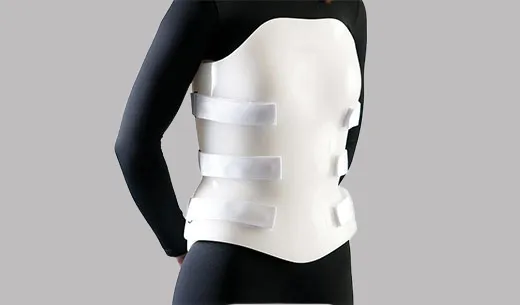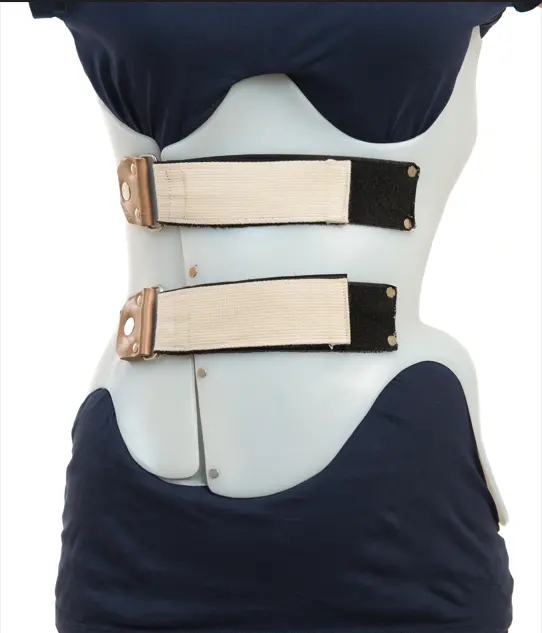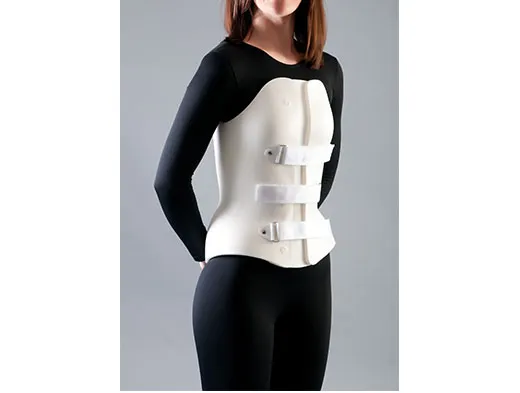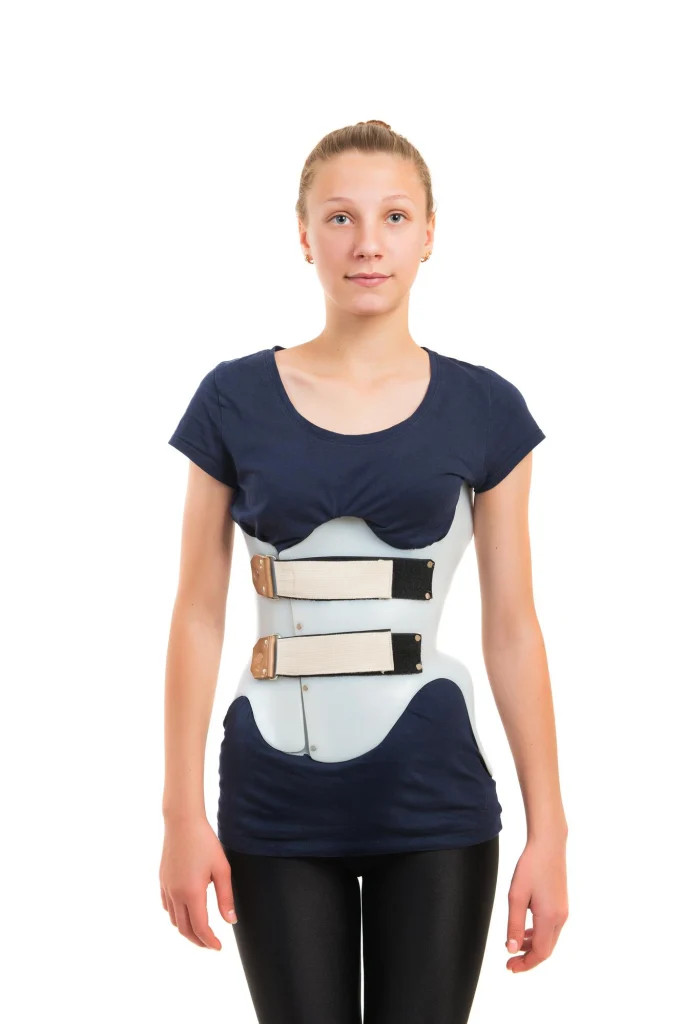If you’ve been struggling with back pain or poor posture, you’re not alone. Many people, from students hunched over laptops to adults working long hours, experience discomfort that can worsen over time. For those with scoliosis, injuries, or spinal conditions, the impact can be even greater.
A back posture corrector, also known as a spinal orthosis or back brace, can help you stand taller, ease pain, and protect your spine. But how do they work? And are they right for you? Let’s break it down in a way that’s simple and easy to understand.

What Is a Back Posture Corrector?
A back posture corrector is a specially designed brace that helps keep your spine in a healthier position. promote faster healing of injured backs during medical treatment and injury recovery. The device assists patients with posture problems, lower back discomfort, and spinal abnormalities. It promotes healing while positioning the spinal area correctly, helping patients achieve better spinal well-being. Doctors recommend them for:
- Poor posture habits
- Scoliosis posture correction
- Spinal injuries or fractures
- Recovery after surgery
- Chronic lower back pain
How Does a Back Posture Corrector Work?
A good posture corrector uses a three-point pressure system to balance and maintain spinal alignment
- One point pushes to correct spinal alignment.
- Two opposite points provide stability.
- Together, they reduce harmful bending or twisting.
By keeping your back in the right position, it allows injured tissues to heal and prevents your spine from getting worse over time.
Common Spinal Conditions That May Need a Back Brace
- Fractures: If you are falling and it hits hard on your back, that could cause a fracture in the spinal bone.
- Intervertebral disc complications: The spine usually has discs (cushions) between the bones. When you lift something heavy, these discs can bulge (herniated discs) or tear, causing pain.
- Spondylolisthesis: Spondylolisthesis is a spinal condition in which one of the spine’s bones slips out from a considerable distance. It causes severe back pain and stiffness.
- Lordosis: Lordosis causes the individual to change their posture, resulting in a sway back appearance, a back that sticks out, with the neck and head leaning forward, and the hips pushing forward. It also creates more symptoms, such as lower back pain, neck pain, and loss of bladder control.
- Kyphosis: The abnormal rounding in the upper back can make it appear hunched or bowed. Poor posture, abnormal vertebrae, developmental problems with the spine, and more can cause it.

- Scoliosis: The sideways curve in the spine can appear as an “S” or “C” shape. It can affect people of any age, starting with children aged 10 to 15. Various conditions, such as congenital, neuromuscular, and specific genes, can cause it.
- Soft tissue injuries: Soft tissue injury in the spine refers to damage to the muscles, ligaments, and tendons surrounding the spinal column rather than the bones. It is commonly caused by sudden movements, overuse, or trauma and leads to pain. It also minimises the range of motion in the affected area.
- Sprain/ strain: Ligaments are fibrous connective tissue in the spine that connects bone at a joint and might stretch or tear, causing a sprain. Meanwhile, tendons are fibrous tissue that attaches muscles to the bone. A sprain may be caused by pulling or overstretching a muscle too hard.
- Muscle injury: Damage to muscle tissue caused by extra pressure, overstretching, or trauma results in pain, swelling, or potential limitations in movement. It is also known as muscle strain, and depending on the severity of the injury, the muscle fibers can be wholly or partially torn.
- Trauma: Usually, trauma can cause the spinal cord to be compressed or torn, which leads to the disruption of nerve signals.
Benefits of a Back Posture Corrector
1. Ease Lower Back Pain: A back brace for lower back pain effectively lessens back pain. It spreads pressure away from your lower back when you sit for a long time, allowing you to move your body naturally while staying pain-free.
2. Correct Your Posture: Spine support helps people who need to sit longer at their desks. Sitting upright in a back brace reduces stress on your spine, neck, and back.
3. Speed Up Recovery: A back braces is essential for effective recovery following a spinal cord injury. After surgical procedures, it helps relax the lower back.
4. Restore Your Mobility: You can use a back support brace despite spine issues when playing sports or hiking. It will stabilize your spine.
Types of Spinal Orthosis (Back Braces)
1. Cervical orthosis (neck braces- CO)
There are both soft-collar and hard-collar braces for cervical space. Both provide warmth and gentle support that doesn’t stop the neck from moving much in a soft collar brace. Meanwhile, stiff plastic rigid collar braces limit movements and support injuries like fractures.
2. Cervicothoracic orthosis (neck and upper back braces- CTO)
The best cervicothoracic orthoses are different braces, including HALO(Halo vest immobilizer), SOMI (Sternal Occipital Mandibular Immobilizer), and Minerva. Halo supports severe neck injuries, while SOMI supports and stabilises the neck and spine. Minerva is crafted to immobilise your spine to permit the ligaments and bones to heal.
3. Cervicothoracolumbar sacral orthosis (full back braces- CTLSO)
It is used to treat kyphosis and high levels of thoracic scoliosis, and this brace goes from the hips to the neck. (Milwaukee brace)
4. Thoracolumbosacral orthosis (mid to lower back braces- TLSO)

There are immense braces that help to prevent the thoracic and lumbar spine.
- Off-the-shelf braces are readymade, which limits your forward bending when used for fractures.
- The spinal/body jacket is a plastic shell that fits around the torso. It is also used for fractures, post-surgery, and unstable spinal problems.
- Scoliosis braces such as Rigo Cheneau are specially designed for scoliosis that control the rotation of your spine.
5. Lumbosacral orthosis (lower back braces- LSO)
There are two kinds of lower back braces: soft fabric lumbar support and molded plastic spinal jackets. Both help treat pain and improve the lower back. In molded brace, it can be customisable.
6. Sacral orthosis (tailbone braces- SO)
It is helpful for sacroiliac joint pain and gives elastic support in the tailbone area.
What is Scoliosis?
Scoliosis is a condition where the spine curves sideways, forming an “S” or “C” shape instead of a straight line. This abnormal curvature can appear during childhood or adolescence, often without obvious symptoms at first. Over time, scoliosis can cause uneven shoulders or hips, muscle fatigue, and in severe cases, breathing difficulties due to the rib cage’s altered shape.
Types of scoliosis
- Idiopathic Scoliosis: Idiopathic scoliosis accounts for most curvatures because doctors must still identify what triggers this condition. The backbone issues commonly start during puberty and grow when young people have growth periods.
- Congenital Scoliosis: This condition exists at birth because the spine develops incorrectly during the fetal period. It may worsen as the child grows.
- Neuromuscular Scoliosis: This type develops in people with conditions like cerebral palsy, muscular dystrophy, or spina bifida, which weaken their muscles and cause the spine to grow out of alignment.
- Degenerative Scoliosis: Adults with this condition develop spinal curvature because of age-related physical changes, including joint damage and weakened bones.
Can a Posture Corrector Help Scoliosis?

Many people ask, Does a posture corrector help scoliosis? The answer is yes, A scoliosis posture corrector is specially designed to support your spine and help slow down the progression of spinal curves. It works by applying gentle, targeted pressure that encourages your spine to maintain a straighter alignment. Here’s how it helps:
- Supports spinal alignment: The corrector applies controlled pressure in key areas to realign the spine gently.
- Reduces strain: It eases muscle tension caused by uneven posture.
- Improves posture: By training your muscles to hold a better position, it can help reduce discomfort and improve appearance.
While a posture corrector is not a cure, it’s an essential part of scoliosis management, especially for growing children and teenagers.
Best Scoliosis Posture Corrector in India
When looking for the best scoliosis posture corrector, consider braces that are:
- Custom-fitted: Tailored to your unique spinal curve using 3D scanning and imaging.
- Comfortable: Lightweight and breathable for long-term wear.
- Clinically recommended: Proven effectiveness for scoliosis management.
Popular Scoliosis Posture Correctors
1. Rigo Cheneau Brace: Widely regarded as the best scoliosis posture corrector, this brace is custom-made to provide precise correction. It uses advanced technology to apply pressure only where needed, improving spinal alignment without restricting movement.
2. TLSO Brace (Thoracolumbosacral Orthosis): A versatile back brace for posture scoliosis, the TLSO offers support for mid to lower back curves and is often recommended for mild to moderate scoliosis cases or post-surgical recovery.
3. Milwaukee Brace: Though bulkier, the Milwaukee brace is effective for high thoracic scoliosis and offers full spine support from the pelvis to the neck.
Rigo Brace vs. TLSO: Which is Right for You
Rigo brace and TLSO are the most effective options for spine-related issues. Let’s compare both with its usability.
| Characteristics | Rigo Cheneau | TLSO |
| Design | It is specially designed to treat scoliosis with precise corrections. | It is versatile and provides adequate support for various spinal conditions. |
| Customisation | You can customize using advanced 3D scans and X-rays for individualised scoliosis care. | This will offer you flexible options for prefabricated or semi-customised products. |
| Correction | It actively guides you with spinal alignment with the proper pressure for better results. | It usually gives support and stabilises the spine, which promotes effective recovery. |
| Indications | It is perfect for managing different types of scoliosis with curvatures. | It is very suitable for mild scoliosis, fractures, and post-operative recovery. |
| Wearability and comfort | It is lightweight and designed to support mobility, making it easy to wear long-term. | It also provides reliable support for enhanced stability and confidence. |
Looking for the best TLSO brace price in India?
Get expert-recommended spinal braces at affordable rates. Book a free consultation today and find the right TLSO brace tailored to your needs and budget.
How to Choose the Right Back Posture Corrector
- Consult Your Doctor: Always get professional advice for your specific spine condition.
- Get Custom Fit: A properly fitted brace is crucial for effectiveness and comfort.
- Check Material Quality: Breathable, durable materials improve wearability.
- Consider Lifestyle: Choose braces that allow mobility if you’re active.
- Follow Instructions: Consistent use and regular follow-ups are necessary for success.
What is the Cost of Posture Corrector in India?

If you’re considering a posture corrector for better spinal health or managing conditions like scoliosis, you may be wondering, How much does it cost in India? Prices vary based on type, material quality, customization, brand, and provider location. Some clinics include consultations and follow-ups, adding extra value.
- Basic posture correctors (for mild posture correction or general support): ₹1,500 – ₹3,000.
- Specialized/custom braces (e.g., Rigo Cheneau, TLSO for scoliosis): ₹10,000 – ₹50,000+, depending on complexity and technology.
Tip: A well-fitted, high-quality brace ensures better comfort and effectiveness in pain relief and posture improvement. Always consult a healthcare professional before buying for the best fit and results.
Common FAQs About Back Posture Correctors and Scoliosis
A: Yes, when worn correctly and combined with medical care, posture correctors and braces can help manage scoliosis effectively.
A: For scoliosis, doctors often recommend wearing the brace most of the day, but it varies by condition and age.
A: Basic posture correctors start from around ₹1,500, while custom scoliosis braces can range from ₹10,000 to ₹50,000 or more depending on customization and materials.
A: While bracing is most effective during growth, adults can still benefit from posture correctors for pain relief and support.
A: This depends on the condition severity and consistency of use, but many patients notice posture improvements and pain relief within weeks to months.
A: In India, KARE Prosthetics & Orthotics is known for its custom-made posture correctors, designed to meet each person’s specific needs. Their expert team ensures every device is comfortable, effective, and supportive, helping improve spinal health while restoring confidence.
Conclusion: Take the First Step Toward a Stronger, Healthier Spine
Living with back pain or scoliosis can feel challenging, but the right back posture corrector can make a big difference. Whether you need posture support, pain relief, or scoliosis management, braces like the Rigo Cheneau and TLSO offer proven benefits.
At KARE Prosthetics & Orthotics, we specialize in creating custom posture correctors and spinal braces designed for comfort and effectiveness, helping you or your loved one regain confidence and move pain-free.
✅ Book a free consultation today to find the best back posture corrector for your unique needs and take the first step toward better spinal health!
See how this person found relief from scoliosis pain with a TLSO back brace for lower back pain from KARE Prosthetics and Orthotics Bangalore. 🎥 Watch our YouTube video ‘Scoliosis pain turns into happiness for Rao!’



